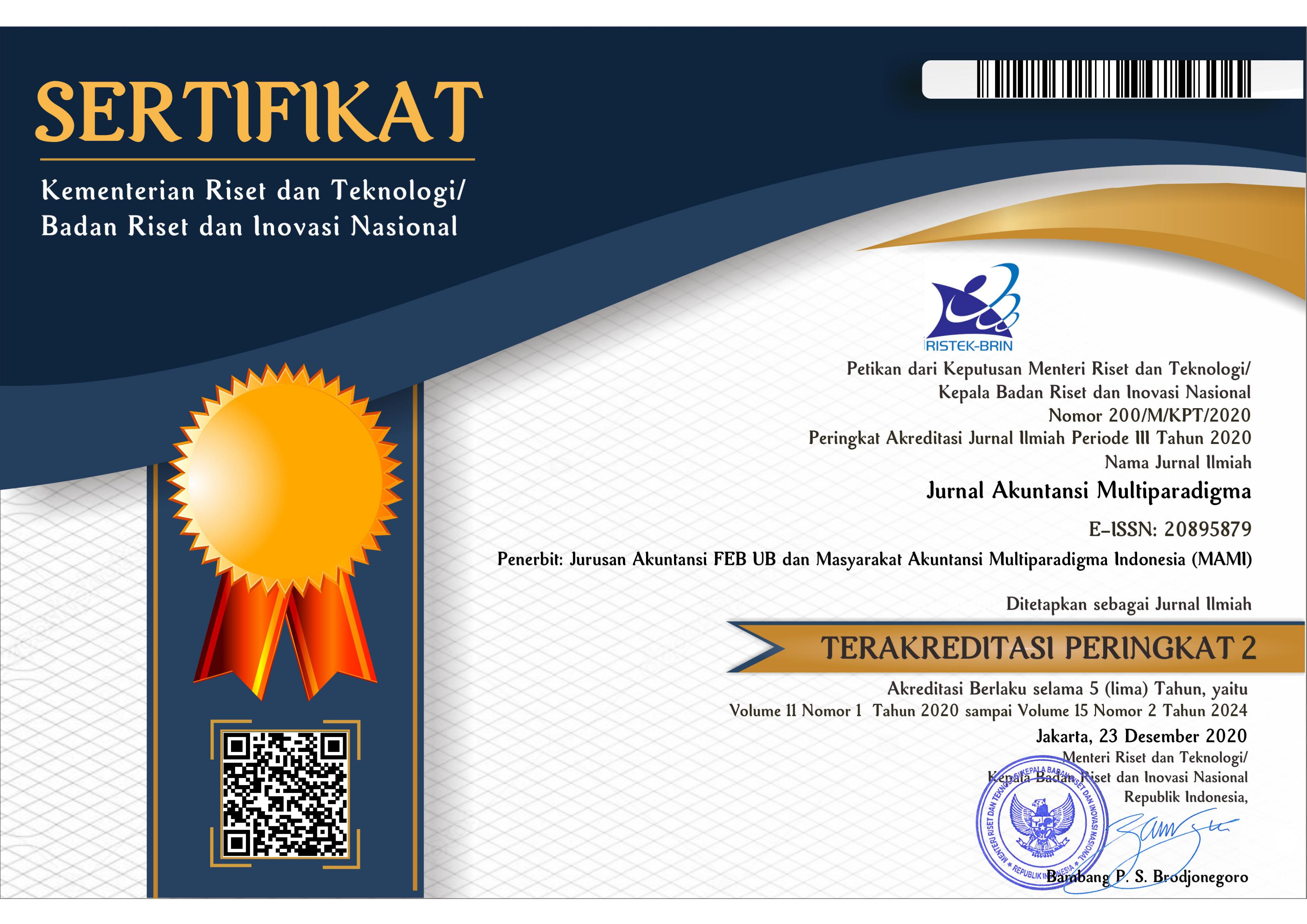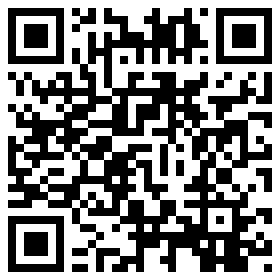KONSEP AKUNTANSI SYARIAH PADA BUDAYA MAHAR
Abstract
Abstrak: Konsep Akuntansi Syariah pada Budaya Mahar. Penelitian ini bertujuan untuk menggali konsep akuntansi syariah dalam budaya mahar. Penelitian ini menggunakan pemikiran burhani sebagai metode. Dalam penelitian ini ditemukan bahwa mahar dalam akuntansi syariah dimaknai sebagai harta, kewajiban, ekuitas, pendapatan, dan beban. Hal ini berakar dari tradisi yang berlaku di masyarakat dalam penerapan unsur-unsur akuntansi syariah dalam budaya mahar. Pengaruh makna, syariah (fiqh) ataupun budaya berdampak pada perbedaan dari segi definisi, jenis, tujuan dan status kepemilikan. Makna budaya mahar dalam akuntansi syariah merefleksikan peran akuntansi yang berbasiskan nilai-nilai religius.
Abstract: The Islamic Accounting Concept in Dowry Culture. This study aims to explore the concept of Islamic accounting in the dowry culture. This research uses Burhani's thinking as a method. This study finds that dowry in Islamic accounting is defined as assets, liabilities, equity, income, and expenses. The definition was rooted in the prevailing tradition in society in the application of elements of Islamic accounting in the dowry culture. The influence of meaning, sharia (fiqh) and culture impacts differences in terms of definition, type, purpose, and ownership status. The meaning of dowry culture in Islamic accounting reflects the role of accounting based on religious values.
Keywords
Full Text:
PDFReferences
Abbas, A. F. (2012). Integrasi pendekatan Bayani, Burhani, dan Irfani dalam Ijtihad Muhammadiyah. AHKAM: Jurnal Ilmu Syariah, 12(1), 51–58. https://doi.org/10.15408/ajis.v12i1.979
Abdel-Baki, M., & Sciabolazza, V. L. (2014). A Consensus-Based Corporate Governance Paradigm for Islamic Banks. Qualitative Research in Financial Markets, 6(1), 93-108. https://doi.org/10.1108/QRFM-01-2013-0002
Abou-El-Sood, H., & El-Ansary, O. (2017). Asset-Liability Management in Islamic Banks: Evidence from Emerging Markets. Pacific Accounting Review, 29(1), 55-78. https://doi.org/10.1108/PAR-04-2016-0050
Agrawal, A. (2014). Situating Marriage Payments: Bride-Price and Dowry Among the Bedias of North India. Contributions to Indian Sociology, 48(2), 223–247. https://doi.org/10.1177/0069966714525164
Ahmad, M. (2009). Psikologi Agama dalam Perspektif Epistemologi Bayani, Burhani dan Irfani. Jurnal Penelitian, 6(1), 1-8. https://doi.org/10.28918/jupe.v6i1.220
Aini, N. (2014). Tradisi Mahar di Ranah Lokalitas Umat Islam: Mahar dan Struktur Sosial di Masyarakat Muslim Indonesia. AHKAM: Jurnal Ilmu Syariah, 17(1), 13-30. https://doi.org/10.15408/ajis.v17i1.1239
Aisyah, S. (2018). Makna Upacara Adat Perkawinan Budaya Melayu Deli terhadap Kecerdasan Emosional. Anthropos: Jurnal Antropologi Sosial dan Budaya, 4(1), 68-78. https://doi.org/10.24114/antro.v4i1.10023
Ali, S. M. (2017). Building Trust in Islamic Finance Products and Services. Society and Business Review, Vol. 12 Issue: 3, pp.356-372, https://doi.org/10.1108/SBR-03-2017-0017
Alifi, N. F. (2017). Tinjauan Hukum Islam terhadap Keterkaitan Antara Sundrang dan Mahar dalam Perkawinan Masyarakat Desa Sase’el Kecamatan Sapeken Kabupaten Sumenep. Al-Hukama': Jurnal Hukum Keluarga Islam di Indonesia, 7(1), 51-75. https://doi.org/10.15642/alhukama.2017.7.1.51-75
Amaliah, T. H., & Sugianto, S. (2018). Konsep Harga Jual Betawian dalam Bingkai Si Pitung. Jurnal Akuntansi Multiparadigma, 9(1), 20-37. https://doi.org/10.18202/jamal.2018.04.9002
Anas, M. (2018). Pembelajaran Akuntansi Berbasis Spiritualitas, Budaya, dan Kearifan Lokal. Jurnal Akuntansi dan Ekonomi, 3(1), 35-42. https://doi.org/10.29407/jae.v3i1.12010
Apriyanti, A. (2017). Historiografi Mahar dalam Pernikahan. An Nisa’a, 12(2), 163–178.
Ar-Razak, A. N. O. (2018). Pelaksanaan Mahar dalam Perkawinan Adat Masyarakat Muna (Sebuah Tinjauan Akomodasi Hukum. Jurnal Al-‘Adl, 11(1), 119-129.
Aziz, A., & Ramdansyah. (2016). Esensi Utang dalam Konsep Ekonomi Islam. Jurnal Bisnis dan Ekonomi Islam, 4(1), 124-135. https://doi.org/10.21043/bisnis.v4i1.1689
Aziz, S. (2017). Tradisi Pernikahan Adat Jawa Keraton Membentuk Keluarga Sakinah. IBDA`: Jurnal Kajian Islam dan Budaya, 15(1), 22-41. https://doi.org/10.24090/ibda.v15i1.724
Baginski, S. P., & Hinson, L. A. (2016). Cost of Capital Free-Riders. The Accounting Review, 91(5), 1291-1313. https://doi.org/10.2308/accr-51379
Baidhawy, Z. (2015). The Role of Faith-Based Organization in Coping With Disaster Management and Mitigation: Muhammadiyah’s Experience. Journal of Indonesian Islam, 9(2), 167-194. https://doi.org/10.15642/JIIS.2015.9.2.167-194
Bahri, S. (2015). Bayani, Burhani, dan Irfani: Trilogi Epistemologi Kegelisahan Seorang Muhammad Abid Al Jabiri. Jurnal Cakrawala Hukum, 11(1), 1-18.
Basri, H. (2017). Konsep Mahar (Maskawin) dalam Tafsir Kontemporer. Al Daulah: Jurnal Hukum Pidana dan Ketatanegaraan, 6(2), 310-330. https://doi.org/10.24252/ad.v6i2.4885
Batubara, S. (2018). Harta dalam Perspektif Alquran: (Studi Tafsir Ayat-Ayat Ekonomi). Imara: Jurnal Riset Ekonomi Islam, 2(2), 139-150. http://dx.doi.org/10.31958/imara.v2i2.1255
Brown, R., & Jones, M. (2015). Mapping and Exploring the Topography of Contemporary Financial Accounting Research. The British Accounting Review, 47I(3), 237-261. https://doi.org/10.1016/j.bar.2014.08.006
Buruadi, M. K., & Eraku, S. (2018). Lenggota Lo Pohutu: Upacara Adat Perkawinan Gorontalo. Gorontalo: Ideas Publishing.
Cook, B. J., & Stathis, M. (2012). Democracy and Islam: Promises and Perils for the Arab Spring Protests. Journal of Global Responsibility, 3(2), 175-186. https://doi.org/10.1108/20412561211260485
Costello, D. M., & Sanders, D. L. (2016). What is Economic Income for Corporate Taxation? The ATA Journal of Legal Tax Research, 14(2), 26-45. https://doi.org/10.2308/jltr-51630
Dewi, R. (2017). Adaptasi Budaya dalam Pernikahan Etnis Tionghoa-Jawa. Interaksi: Jurnal Ilmu Komunikasi, 6(2), 32-37. https://doi.org/10.14710/interaksi.6.2.32-37
Díaz‐Giménez, J., & Giolito, E. (2013), Accounting for the Timing of First Marriage. International Economic Review, 54(1), 135-158. https://doi.org/10.1111/j.1468-2354.2012.00728.x
Efferin, S. (2015). Akuntansi, Spiritualitas, dan Kearifan Lokal: Beberapa Agenda Penelitian Kritis. Jurnal Akuntansi Multiparadigma, 6(3), 466-480. https://doi.org/10.18202/jamal.2015.12.6037
Fardayanti, Y., & Nurman. (2013). Eksistensi Tradisi Juadah dalam Melestarikan Solidaritas dalam Upacara Perkawinan (Studi di Korong Kampung Ladang Kabupaten Padang Pariaman). Humanus: Jurnal Ilmiah Ilmu-Ilmu Humaniora, 12(1), 43-52. https://doi.org/10.24036/jh.v12i1.3103
Fauzia, I. Y. (2018). The Islamic Models of Saving and Investment sebagai Suatu Tawaran atas Perilaku Impulse Buying pada Produk dan Jasa Taḥsīnīyāt. ISLAMICA: Jurnal Studi Keislaman, 12(2), 384-404. https://doi.org/10.15642/islamica.2018.12.2.155-175
Fikri, M., Karim, N., & Widyastuti, W. (2017). Akuntansi Pernikahan di Pulau Lombok. Jurnal Riset Akuntansi Aksioma, 15(2), 1-16. https://doi.org/10.29303/aksioma.v15i2.9
Fuadi, N. (2018). Wakaf sebagai Instrumen Ekonomi Pembangunan Islam. Economica: Jurnal Ekonomi Islam, 9(1), 151-177. https://doi.org/10.21580/economica.2018.9.1.2711
Fülbier, R. U., & Klein, M. (2015). Balancing Past and Present: The Impact of Accounting Internationalisation on German Accounting Regulations. Accounting History, 20(3), 342–374. https://doi.org/10.1177/1032373215595300
Gamon, A., & Tagoranao, M. (2018). Zakat and Poverty Alleviation in a Secular State: The Case of Muslim Minorities in the Philippines. Studia Islamika, 25(1), 97-133. https://doi.org/10.15408/sdi.v25i1.5969
Gani, B. A., & Hayati, A. (2017). Pembatasan Jumlah Mahar Melalui Keputusan Musyawarah Adat Kluet Timur. Samarah: Jurnal Hukum Keluarga dan Hukum Islam, 1(1), 174-204. https://doi.org/10.22373/sjhk.v1i1.1575
Halomoan, P. (2015). Penetapan Mahar terhadap Kelangsungan Pernikahan Ditinjau Menurut Hukum Islam. Jurnal Ilmiah Syariah, 14(2), 108-118. https://doi.org/10.31958/juris.v14i2.301
Haniffa, R., & Hudaib, M. (2010). The Two Ws of Islamic Accounting Research. Journal of Islamic Accounting and Business Research, 1(1), 5-9. https://doi.org/10.1108/17590811011033370
Hardy, L., & Ballis, H. (2013). Accountability and Giving Accounts: Informal Reporting Practices in a Religious Corporation. Accounting, Auditing & Accountability Journal, 26(4), 539-566. https://doi.org/10.1108/09513571311327453
Huda, M. (2017). Membangun Model Bernegosiasi dalam Tradisi Larangan-Larangan Perkawinan Jawa. Episteme: Jurnal Pengembangan Ilmu Keislaman, 12(2), 381-409. https://doi.org/10.21274/epis.2017.12.2.381-409
Ibrahim, A. A., Elatrash, R. J., & Farooq, M. O. (2014). Hoarding versus Circulation of Wealth from the Perspective of Maqasid Al-Shari'ah. International Journal of Islamic and Middle Eastern Finance and Management, 7(1), 6-21. https://doi.org/10.1108/IMEFM-06-2012-0053
Ikatan Akuntan Indonesia. (2017). Pedoman Standar Akuntansi Syariah. Jakarta: Dewan Standar Keuangan.
Iska, S. (2015). Perspektif Fikih Ekonomi terhadap Pelaksanaan Akad “Utang Piutang” pada Perbankan Syariah di Sumatera Barat. Jurnal Ilmiah Syariah, 14(2), 21-34. https://doi.org/10.31958/juris.v14i2.306
Isnaeni, A., & Hakiki, K. M. (2016). Simbol Islam dan Adat dalam Perkawinan Adat Lampung Pepadun. Kalam, 12(2), 193-222. https://doi.org/10.24042/klm.v10i1.341
Iswandi, A. (2014). Maslahat Memelihara Harta dalam Sistem Ekonomi Islam. SALAM: Jurnal Sosial dan Budaya Syar-i, 1(1), 19-31. https://doi.org/10.15408/sjsbs.v1i1.1522
Kamla, R. (2015). Critical Muslim Intellectuals’ Thought: Possible Contributions to the Development of Emancipatory Accounting Thought. Critical Perspectives on Accounting, 31, 64-74. https://doi.org/10.1016/j.cpa.2015.01.014
Kashif, M., Jamal, K. F., & Rehman, M. A.(2018). The Dynamics of Zakat Donation Experience among Muslims: A phenomenological Inquiry. Journal of Islamic Accounting and Business Research, 9(1), 45-58. https://doi.org/10.1108/JIABR-01-2016-0006
Komori, N. (2012). Visualizing the Negative Space: Making Feminine Accounting Practices Visible by Reference to Japanese Women's Household Accounting Practices. Critical Perspectives on Accounting, 23(6), 451-467. https://doi.org/10.1016/j.cpa.2012.04.006
Kuasirikun, N., & Constable, P. (2010). The Cosmology of Accounting in Mid 19th-Century Thailand. Accounting, Organizations and Society, 35(6), 596-627. https://doi.org/10.1016/j.aos.2010.01.004
Lee, S., Choe, H., & Kim, M. (2017). Mental Accounting of Retired Household by the Type of Household Financial Strategy. Korean Journal of Human Ecology, 26(5), 403-417. https://doi.org/10.5934/kjhe.2017.26.5.403
Licini, S. (2011). Assessing Female Wealth in Nineteenth Century Milan, Italy. Accounting History, 16(1), 35–54. https://doi.org/10.1177/1032373210389591
Ma’u, D. H. (2013). Harta dalam Perspektif Al-Qur ’ an. Khatulistiwa: Journal of Islamic Studies, 3(1), 86–100. https://doi.org/10.24260/khatulistiwa.v3i2.215
Mantau, M. (2016). Ungkapan Bermakna Budaya dalam Upacara Adat Pernikahan Masyarakat Etnik Gorontalo. Kadera Bahasa, 8(1), 105-122. https://doi.org/10.26499/kaba.v8i1.24
Mukhlisin, M., Hudaib, M., & Azid, T. (2015). The Need for Shariah Harmonization in Financial Reporting Standardization: The Case of Indonesia. International Journal of Islamic and Middle Eastern Finance and Management, 8(4), 455-471. https://doi.org/10.1108/IMEFM-10-2013-0110
Mulawarman, A. (2010). Integrasi Paradigma Akuntansi: Refleksi atas Pendekatan Sosiologi dalam Ilmu Akuntansi. Jurnal Akuntansi Multiparadigma, 1(1), 155-171. https://doi.org/10.18202/jamal.2010.04.7086
Mulawarman, A. D., & Kamayanti, A. (2018). Towards Islamic Accounting Anthropology: How Secular Anthropology Reshaped Accounting in Indonesia. Journal of Islamic Accounting and Business Research, 9(4), 629-647. https://doi.org/10.1108/JIABR-02-2015-0004
Mun, Y. L., & Thaker, H. M. T. (2016). Asset Liability Management of Conventional and Islamic Banks in Malaysia. Al-Iqtishad: Jurnal Ilmu Ekonomi Syariah, 9(1), 33-52. https://doi.org/10.15408/aiq.v9i1.3334
Nalle, S. T. (2017). Women’s Status, Family Systems, and Marriage in a Time of Economic Crisis: Cuenca, 1500–1650. Journal of Family History, 42(3), 236–249. https://doi.org/10.1177/0363199017710955
Nishikawa, I., Kamiya, T., & Kawanishi, Y. (2016). The Definitions of Net Income and Comprehensive Income and Their Implications for Measurement. Accounting Horizons, 30(4), 511-516. https://doi.org/10.2308/acch-51544
Niswatin, N., Noholo, S., Tuli, H., & Wuryandini, A. (2017). Perilaku Pengusaha Mikro Betawi Perantauan terhadap Cost Reduction. Jurnal Akuntansi Multiparadigma, 8(3), 427-443. https://doi.org/10.18202/jamal.2017.12.7064
Nurlaelawati, E. (2010). Zakat and the Concept of Ownership in Islam: Yusuf Qaradawi’s Perspective on Islamic Economics. Al-Jami'ah: Journal of Islamic Studies, 48(2), 365-385. https://doi.org/10.14421/ajis.2010.482.365-385
Nurlia, N., & Nurasiah. (2017). Sunrang Tanah sebagai Mahar untuk Meningkatkan Identitas Diri Perempuan dalam Perkawinan Bugis Makassar. Jurnal Dakwah Tabligh, 18(1), 1-15. https://doi.org/10.24252/jdt.v18i1.2861
Nurwahidah & Mustari. (2014). Kedudukan Sompa (Mahar) dan Uang Belanja dalam Perkawinan Mayarakat di Kelurahan Pasir Putih Kecamatan Sinjai Borong Kabupaten Sinjai. Jurnal Tomalebb, 1(1), 69-83.
Patel, G. H. (2017). Islam and Capital, Mortared by Trust: The Case of Sri Lanka. Society and Business Review, 12(3), 373-394. https://doi.org/10.1108/SBR-07-2017-0045
Puji, L. N. (2018). Nilai Budaya dalam Tradisi Lisan Pernikahan Adat Dayak Maanyan di Kalimantan Tengah. Jurnal Bahasa, Sastra dan Pembelajarannya, 8(1), 101-112. https://doi.org/10.20527/jbsp.v8i1.4815
Raden, S. (2011). Pelaksanaan Upacara Mematua dan Mandiu PasilidDalam Perkawinan Adat Suku KailI (Suatu Tinjauan Hukum Islam dan Hukum Adat). Hunafa: Jurnal Studia Islamika, 8(2), 363-396. https://doi.org/10.24239/jsi.v8i2.369.363-396
Ragoan, S., Untoro, V., & Ari, D. R. (2017). Gambaran Kepuasan Pernikahan pada Wanita Keturunan Arab yang Melakukan Pernikahan dengan Etnis Lain. Jurnal Psikologi Ulayat, 4(2), 107-121. https://doi.org/10.24854/jpu22017-99
Rahayu, S., & Yudi. (2015). Uang Nai': Antara Cinta dan Gengsi. Jurnal Akuntansi Multiparadigma, 6(2), 224-236. https://doi.org/10.18202/jamal.2015.08.6018
Razak, L. A., & Saupi, M. N. (2017). The Concept and Application of Ḍamān Al-Milkiyyah (Ownership Risk): Islamic Law of Contract Perspective. ISRA International Journal of Islamic Finance, 9(2), 148-163. https://doi.org/10.1108/IJIF-06-2017-0002
Reitz, C. (2016). Accounting for Inequality: Questioning Piketty on National Income Accounts and the Capital-Labor Split. Review of Radical Political Economics, 48(2), 310–321. https://doi.org/10.1177/0486613415605075
Ridwan, A. (2016). Kritik Nalar Arab: Eksposisi Epistemologi Bayani, ‘Irfani dan Burhani Muhammad Abed Al-Jabiri. Afkaruna: Indonesian Interdisciplinary Journal of Islamic Studies, 12(2), 187-222.
Rodin, D. (2015). Pemberdayaan Ekonomi Fakir Miskin dalam Perspektif Al-Qur’an. Economica: Jurnal Ekonomi Islam, 6(1), 71-102. https://doi.org/10.21580/economica.2015.6.1.787
Rozario, S. (2011). Islamic Piety Against the Family: From ‘Traditional’ to ‘Pure’ Islam. Contemporary Islam, 5(3), 285-308. https://doi.org/10.1007/s11562-011-0166-7
Sabac, F., & Tian, J. J. (2015) On the Stewardship Value of Soft Managerial Reports. The Accounting Review, 90(4), 1683-1706. https://doi.org/10.2308/accr-50946
Salampessy, Z., Triyuwono, I., Irianto, G., & Hariadi, B. (2018). Pancasila Paradigm: Methodology of Wawasan Nusantara for Accounting of Pancasila. Australasian Accounting, Business and Finance Journal, 12(1), 102-115. https://doi.org/10.14453/aabfj.v12i1.7
Salihin, A., Fatima, A. H., & Ousama, A. A. (2014). An Islamic Perspective on the True and Fair View Override Principle. Journal of Islamic Accounting and Business Research, 5(2), 142-157. https://doi.org/10.1108/JIABR-12-2011-0005
Salleh, A. M. H. A. P. M. (2015). Integrating Financial Inclusion and Saving Motives into Institutional Zakat Practices: A Case Study on Brunei. International Journal of Islamic and Middle Eastern Finance and Management, 8(2), 150-170. https://doi.org/10.1108/IMEFM-12-2013-0126
Sangster, A. (2018). Pacioli's Lens: God, Humanism, Euclid, and the Rhetoric of Double Entry. The Accounting Review, 93(2), 299-314. https://doi.org/10.2308/accr-51850
Setiowati, N. E. (2016). Perempuan, Strategi Nafkah dan Akuntansi Rumah Tangga. Al-Amwal: Jurnal Kajian Ekonomi dan Perbankan Syariah), 8(1), 298-304. https://doi.org/10.24235/amwal.v8i1.664
Soucy, A. (2014). Wedding Invitations and Relationship Management in Hanoi. The Asia Pacific Journal of Anthropology, 15(2), 141–157. https://doi.org/10.1080/14442213.2014.892527
Suardikha, I. M. S., Budiasih, I. G. A. N., & Erawati, N. M. A. (2018). Praktik Akuntansi Betawian dalam Perspektif Kuasa dan Pengetahuan. Jurnal Akuntansi Multiparadigma, 9(1), 1–19. https://doi.org/10.18202/jamal.2018.04.9001
Sugianto, B. (2011). Kualitas dan Kuantitas Mahar dalam Perkawinan (Kasus Wanita yang Menyerahkan Diri kepada Nabi Saw). Asy-Syir'ah, 45(2), 1357-1381. https://doi.org/10.14421/asy-syir'ah.2011.%25x
Syarifuddin, S., & Damayanti, R. (2015). Story of Bride Price: Sebuah Kritik atas Fenomena Uang Panaik Suku Makassar. Jurnal Akuntansi Multiparadigma, 6(1), 79-98. https://doi.org/10.18202/jamal.2015.04.6007
Thomson, I. (2014). Responsible Social Accounting Communities, Symbolic Activism and the Reframing of Social Accounting, A Commentary on New Accounts: Towards a Reframing of Social Accounting. Accounting Forum, 38(4), 275-277. https://doi.org/10.1016/j.accfor.2014.05.002
Triyuwono, I. (2011). Mengangkat ”Sing Liyan” untuk Formulasi Nilai Tambah Syari’ah. Jurnal Akuntansi Multiparadigma, 2(2), 186-200. https://doi.org/10.18202/jamal.2011.08.7116
Tumirin, & Abdurahim, A. (2015). Makna Biaya dalam Upacara Rambu Solo. Jurnal Akuntansi Multiparadigma, 6(2), 175-184. https://doi.org/10.18202/jamal.2015.08.6014
Ulum, F. (2017). Brotherhood dalam Dimensi Sistem Ekonomi Islam. ISLAMICA: Jurnal Studi Keislaman, 11(2), 499-521. https://doi.org/10.15642/islamica.2017.11.2.499-521
Umam, K. (2016). Konsep Uang Islam: Antara Uang Komoditas atau Uang Fiat. Islamic Economics Journal, 2(1), 91-108. https://doi.org/10.21111/iej.v2i1.972
Virtanen, A. (2009). Accounting, Gender and History: The Life of Minna Canth. Accounting History, 14(1–2), 79–100. https://doi.org/10.1177/1032373208098553
Warwick, F., & Robert, W. (2014). The Religious Imperative of Cost Accounting in the Early Industrial Revolution. Accounting, Auditing & Accountability Journal, 27(2), 357-381. https://doi.org/10.1108/AAAJ-03-2013-1269
Wilkinson, M. N. L. (2013). Introducing Islamic Critical Realism. Journal of Critical Realism, 12(4), 419-442. https://doi.org/10.1179/1476743013Z.00000000014
Yahaya, N. (2015), Craving Bureaucracy: Marriage, Islamic Law, and Arab Petitioners in the Straits Settlements. The Muslim World, 105(4), 496-515. https://doi.org/10.1111/muwo.12108
Yamamoto, K., & Noguchi, M. (2013). Different Scenarios for Accounting Reform in Non-Anglophone Contexts: The Case of Japanese Local Governments Since the 1990s. Accounting History, 18(4), 529–549. https://doi.org/10.1177/1032373213509678
Yusuf, M. (2015). Women Leadership in Local Wisdom Perspective: Bugis Muslims Scholars’ Thought and Bugis Culture. Analisa: Journal of Social Science and Religion, 22(1), 69-81. https://doi.org/10.18784/analisa.v22i1.142
Za, M. A. S. (2016). Konsep Harta Perspektif Ekonomi Islam. Akademika, 10(2), 264-278. https://doi.org/10.30736/akademika.v10i2.23
Zakiyah. (2011). Islamic Welfare System Dealing with the Poor in Rural Area. Indonesian Journal of Islam and Muslim Societies, 1(1), 37-67. https://doi.org/10.18326/ijims.v1i1.37-67
DOI: http://dx.doi.org/10.18202/jamal.2019.04.10005
Refbacks
- There are currently no refbacks.
Copyright (c) 2019 Yuyanti Rahman, Sahmin Noholo, Ivan Rahmat Santoso

This work is licensed under a Creative Commons Attribution-NonCommercial 4.0 International License.

















